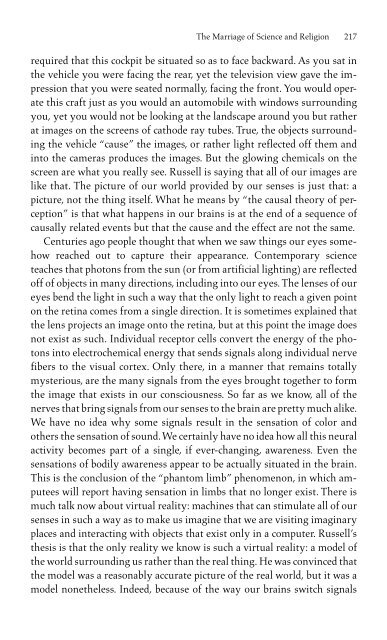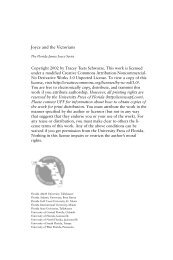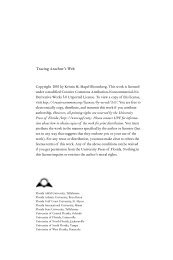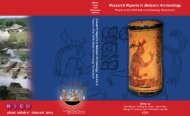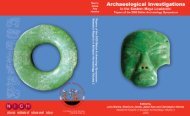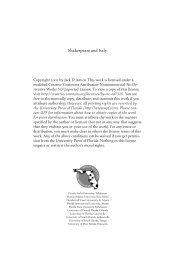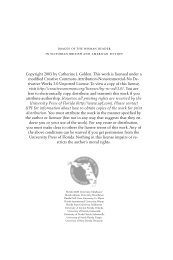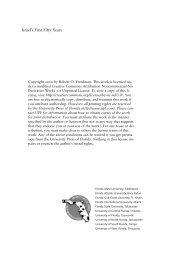Bernard Shaw's Remarkable Religion: A Faith That Fits the Facts
Bernard Shaw's Remarkable Religion: A Faith That Fits the Facts
Bernard Shaw's Remarkable Religion: A Faith That Fits the Facts
You also want an ePaper? Increase the reach of your titles
YUMPU automatically turns print PDFs into web optimized ePapers that Google loves.
The Marriage of Science and <strong>Religion</strong> 217<br />
required that this cockpit be situated so as to face backward. As you sat in<br />
<strong>the</strong> vehicle you were facing <strong>the</strong> rear, yet <strong>the</strong> television view gave <strong>the</strong> impression<br />
that you were seated normally, facing <strong>the</strong> front. You would operate<br />
this craft just as you would an automobile with windows surrounding<br />
you, yet you would not be looking at <strong>the</strong> landscape around you but ra<strong>the</strong>r<br />
at images on <strong>the</strong> screens of cathode ray tubes. True, <strong>the</strong> objects surrounding<br />
<strong>the</strong> vehicle “cause” <strong>the</strong> images, or ra<strong>the</strong>r light reflected off <strong>the</strong>m and<br />
into <strong>the</strong> cameras produces <strong>the</strong> images. But <strong>the</strong> glowing chemicals on <strong>the</strong><br />
screen are what you really see. Russell is saying that all of our images are<br />
like that. The picture of our world provided by our senses is just that: a<br />
picture, not <strong>the</strong> thing itself. What he means by “<strong>the</strong> causal <strong>the</strong>ory of perception”<br />
is that what happens in our brains is at <strong>the</strong> end of a sequence of<br />
causally related events but that <strong>the</strong> cause and <strong>the</strong> effect are not <strong>the</strong> same.<br />
Centuries ago people thought that when we saw things our eyes somehow<br />
reached out to capture <strong>the</strong>ir appearance. Contemporary science<br />
teaches that photons from <strong>the</strong> sun (or from artificial lighting) are reflected<br />
off of objects in many directions, including into our eyes. The lenses of our<br />
eyes bend <strong>the</strong> light in such a way that <strong>the</strong> only light to reach a given point<br />
on <strong>the</strong> retina comes from a single direction. It is sometimes explained that<br />
<strong>the</strong> lens projects an image onto <strong>the</strong> retina, but at this point <strong>the</strong> image does<br />
not exist as such. Individual receptor cells convert <strong>the</strong> energy of <strong>the</strong> photons<br />
into electrochemical energy that sends signals along individual nerve<br />
fibers to <strong>the</strong> visual cortex. Only <strong>the</strong>re, in a manner that remains totally<br />
mysterious, are <strong>the</strong> many signals from <strong>the</strong> eyes brought toge<strong>the</strong>r to form<br />
<strong>the</strong> image that exists in our consciousness. So far as we know, all of <strong>the</strong><br />
nerves that bring signals from our senses to <strong>the</strong> brain are pretty much alike.<br />
We have no idea why some signals result in <strong>the</strong> sensation of color and<br />
o<strong>the</strong>rs <strong>the</strong> sensation of sound. We certainly have no idea how all this neural<br />
activity becomes part of a single, if ever-changing, awareness. Even <strong>the</strong><br />
sensations of bodily awareness appear to be actually situated in <strong>the</strong> brain.<br />
This is <strong>the</strong> conclusion of <strong>the</strong> “phantom limb” phenomenon, in which amputees<br />
will report having sensation in limbs that no longer exist. There is<br />
much talk now about virtual reality: machines that can stimulate all of our<br />
senses in such a way as to make us imagine that we are visiting imaginary<br />
places and interacting with objects that exist only in a computer. Russell’s<br />
<strong>the</strong>sis is that <strong>the</strong> only reality we know is such a virtual reality: a model of<br />
<strong>the</strong> world surrounding us ra<strong>the</strong>r than <strong>the</strong> real thing. He was convinced that<br />
<strong>the</strong> model was a reasonably accurate picture of <strong>the</strong> real world, but it was a<br />
model none<strong>the</strong>less. Indeed, because of <strong>the</strong> way our brains switch signals


